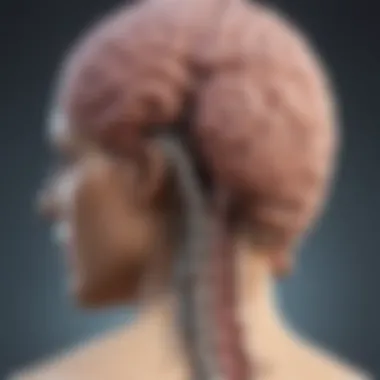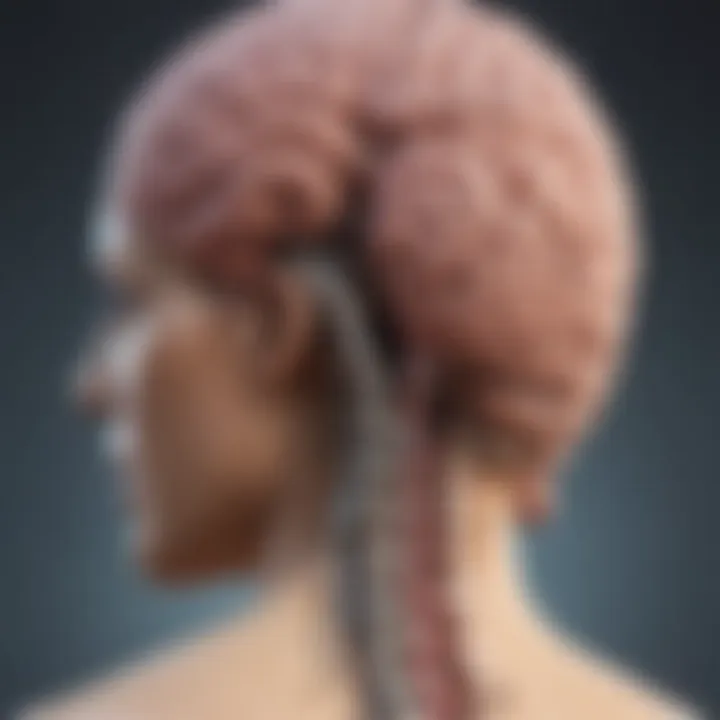Understanding Chiari Syndrome: A Thorough Overview


Research Overview
Chiari Syndrome, while a somewhat obscure term in many circles, reveals a complex tapestry of neurological complications that can affect individuals profoundly. Understanding this condition entails unraveling the intricate connections between anatomy, symptoms, and treatment. Below, we summarize key findings that provide insight into this condition's significance.
Summary of Key Findings
Research shows that Chiari Syndrome is classified into various types, with Type I being the most common. Each type exhibits distinct characteristics that can lead to varying degrees of symptoms.
- Genetic Factors: Some studies suggest that hereditary elements may play a role in the manifestation of the disease.
- Symptoms Can Vary: Symptoms, which might range from headaches to more severe neurological issues, vary widely among patients.
- Diagnostic Techniques: Magnetic Resonance Imaging (MRI) has emerged as a crucial tool for diagnosing this syndrome accurately, revealing structural changes in the brain.
These findings underscore the necessity for heightened awareness and further research into the mechanisms and implications of Chiari Syndrome.
Background and Context
Chiari Syndrome was first described at the end of the 19th century, yet it remains a topic of contention and exploration within the medical community. Patients experience a multitude of symptoms due to the displacement of brain tissue into the spinal canal, which can interfere with normal bodily functions.
The disorder poses unique challenges, particularly in terms of diagnosis and treatment. While some individuals remain asymptomatic, others might end up grappling with disadvantages that significantly hinder their quality of life. This juxtaposition creates a fertile ground for ongoing discussion within both clinical and academic circles.
"The condition requires not only medical intervention but also psychological understanding, as the impacts on everyday life can be severe."
Methodology
Understanding Chiari Syndrome effectively necessitates a multi-faceted approach that combines various research methods, offering a robust exploration of the condition.
Experimental Design
Research on Chiari Syndrome often involves observational studies and longitudinal research to track individuals affected over time. Experiments typically aim to examine the relationship between brain displacements and associated symptoms. These studies might scrutinize variations among distinct patient cohorts, looking at both symptomatic and asymptomatic individuals to disentangle their experiences.
Data Collection Techniques
Data collection for studies on Chiari Syndrome varies widely. Common techniques include:
- Clinical interviews that allow for a comprehensive understanding of patient histories and symptom progression.
- MRI scans to visualize and assess the extent of brain tissue displacement.
- Questionnaires designed to quantify the impact of symptoms on daily life, allowing researchers to gather qualitative and quantitative data.
This methodological rigor aids in piecing together the fragmented picture of Chiari Syndrome, laying the groundwork for future inquiries into its management and treatment.
Intro to Chiari Syndrome
Chiari Syndrome is not just a medical term that rolls off the tongue; it embodies the struggles faced by those dealing with a neurological condition that often remains shrouded in mystery for many. Understanding this syndrome requires us to dive into its complexities and implications. By gathering insights into its definition, historical context, and symptomatology, we create a solid foundation that allows individuals—be it patients, healthcare professionals, or advocates—to better navigate this multifaceted disorder.
Definition and Scope
Chiari Syndrome, often referred to as Chiari malformation, comprises a group of conditions where brain tissue extends into the spinal canal. This definition, while straightforward, does not do justice to the breadth of experiences associated with the syndrome. The severity of Chiari can vary vastly from one individual to another; in fact, some people may remain asymptomatic while others deal with debilitating pain or neurological deficits.
This condition typically manifests in four distinct types, each defined by the degree of brain tissue displacement. But Chiari Syndrome is more than just its definitions; it brings forth a myriad of symptoms ranging from headaches and neck pain to coordination problems and even emotional distress. Understanding the full scope of Chiari demands an exploration of not just the clinical aspects, but also its impact on daily life and the intricacies of living with it.
Historical Background
The journey of Chiari Syndrome through the annals of medical history has been enlightening, to say the least. The first documentation can be traced to the work of Austrian pathologist Hans Chiari in the 1890s, who described the anatomical abnormalities associated with the syndrome. Yet, it wasn't until the mid-20th century that advancements in neuroimaging began to shed light on this condition. The evolution of diagnostic methods, particularly Magnetic Resonance Imaging, revolutionized the way physicians viewed Chiari malformation, allowing for earlier and more accurate diagnoses.
"Understanding the history of a condition helps us appreciate how far we've come and the strides yet to be made." - Unknown
Currently, the medical community recognizes the importance of interdisciplinary collaboration in managing Chiari Syndrome. As knowledge grows, so too does the importance of patient advocacy, ensuring that those affected are given a voice. Every experience informs our understanding, revealing not just the anatomical realities but also the human stories intertwined with Chiari Syndrome.
In the sections that follow, we will delve deeper into the clinical classification, etiology, symptoms, diagnostic approaches, and treatment options. This exploration will provide a comprehensive understanding, shedding light on what it truly means to live with Chiari Syndrome.
Clinical Classification of Chiari Malformations
Understanding the clinical classification of Chiari malformations is pivotal when examining Chiari Syndrome. This categorization not only aids in identifying the specific type of malformation but also plays a critical role in determining treatment approaches and prognostic factors. Each type presents distinct anatomical characteristics, which influence the range and severity of symptoms experienced by individuals. By grasping these classifications, healthcare professionals can craft tailored management plans and enhance the overall quality of life for those affected.
Chiari Type
Chiari Type I is perhaps the most commonly diagnosed form of the malformation. In this type, the cerebellar tonsils extend downward through the foramen magnum, which is the opening at the base of the skull. This displacement often results in varying neurological symptoms, including headache, neck pain, and balance issues. Patients may not display symptoms until adolescence or adulthood, making early detection challenging.
The importance of recognizing this type early cannot be overstated. Appropriate imaging techniques, often through MRI, can confirm the diagnosis. This type may potentially lead to more serious complications, such as syringomyelia, where a cyst forms within the spinal canal.
Chiari Type
Chiari Type II is usually identified in infants or at birth and is often associated with spina bifida. In this malformation, both the cerebellum and brainstem are displaced into the spinal canal, often causing a range of neurological deficits. Symptoms can include difficulty swallowing, weakness, and problems with motor control.
The severity of conditions associated with Chiari Type II often demands a proactive approach to treatment. Many cases require surgical intervention shortly after diagnosis to avoid severe complications. Identifying this type is crucial in the neonatal period, emphasizing the need for early intervention.


Chiari Type
Chiari Type III is a more severe and rare type, characterized by parts of the cerebellum and brainstem protruding through the skull and into the spinal canal. This type is typically associated with significant neurological deficits and is usually apparent at birth. The prognosis for Chiari Type III is often less favorable, with many individuals experiencing substantial complications throughout their lives.
In managing Chiari Type III, immediate surgical intervention is generally necessary to address both the structural abnormality and to mitigate further neurological damage. Continuous follow-up and rehabilitation are vital for improving outcomes.
Chiari Type
Chiari Type IV is unique in that it involves an underdeveloped cerebellum, often accompanied by other severe central nervous system anomalies. Unlike other types, this condition is often not compatible with life and is rarely diagnosed outside of prenatal imaging. Children born with this malformation face significant hurdles, and medical discussions often revolve around palliative care rather than aggressive intervention.
In summary, understanding these classifications does more than just label a condition; it directly influences the patient's journey and potential outcomes. Identifying the type of Chiari malformation helps in curating the right protocols for treatment while fostering awareness regarding the lifelong implications of the syndrome.
Etiology of Chiari Syndrome
Understanding the etiology of Chiari Syndrome is pivotal because it lays the groundwork for grasping how and why this neurological disorder manifests in individuals. By looking into the factors that contribute to its development, one can not only appreciate the complexity of the syndrome but also focus on the nuanced approaches to treatment and management. Importantly, recognizing whether Chiari Malformation arises from congenital or acquired instances shapes the need for targeted interventions tailored to each patient's unique situation.
Congenital Factors
Congenital factors play a significant role in Chiari Syndrome. This aspect essentially refers to conditions that are present at birth and can lead to the malformation of the brain and spinal structures, inevitably pushing the brain tissue downward into the spinal canal. Several anatomical anomalies can be linked back to genetic predisposition, causing disorders during embryonic development.
For instance, a well-known condition associated with Chiari Malformation is Arnold-Chiari Malformation, which primarily affects the cerebellum's structure. If the skull is smaller than average, or if the brain doesn't grow properly, these changes can increase the likelihood of brain displacement.
Some congenital factors that can contribute include:
- Atlas anomalies: These involve deformities of the first cervical vertebra, possibly influencing how the brain rests on the spine.
- Occipital bone defects: This area's malformation can create more room in the skull, thus increasing the risk of brain tissue being pushed through the foramen magnum, the opening at the base of the skull.
- Syringomyelia: This condition, where a cyst forms in the spinal cord, often correlates with Chiari Type I, marking it as a common congenital connection.
These elements suggest that individuals born with specific structural conditions are at a higher risk of developing Chiari Malformation, making awareness and early diagnosis essential for better outcomes.
Acquired Factors
On the flip side, acquired factors pertain to conditions or events that develop over time, which can aggravate or lead to Chiari Syndrome in individuals who might not have congenital forms of the disorder. These factors can be just as significant and often catch patients by surprise as they navigate their health.
Acquired Chiari Syndrome might arise from:
- Trauma: An injury to the skull or spine can displace the brain tissue post-birth. Such incidents can occur in accidents, falls, or sports injuries.
- Infections or Inflammation: Conditions resulting in brain swelling, such as meningitis or encephalitis, might lead to structural changes.
- Tumors or Masses: Any growth in the cranial area that shifts anatomical landmarks can cause secondary Chiari effects.
Addressing these factors is vital, not just for individual treatment but also for understanding root causes. Awareness of acquired elements reinforces the importance of prevention and timely action, particularly for those engaged in high-risk activities.
"A comprehensive understanding of both congenital and acquired factors illuminates the multifaceted nature of Chiari Syndrome, leading to improved treatment options and patient education."
Both congenital and acquired factors of Chiari Syndrome highlight the need for a holistic understanding of the condition. By identifying these elements, we can better manage the syndrome and explore personalized care paths for those affected.
Symptoms and Clinical Presentation
Understanding the symptoms and clinical presentation of Chiari Syndrome is essential. This knowledge not only aids in early detection but also enhances the overall management of the condition. Individuals affected by Chiari Syndrome often experience a wide range of symptoms, which can vary in intensity and duration. Recognizing these symptoms is crucial for healthcare professionals to differentiate Chiari from other neurological disorders, ensuring that patients receive appropriate treatment in a timely manner.
Neurological Symptoms
Neurological symptoms are typically at the forefront of Chiari Syndrome's clinical presentation. One may encounter an assortment of issues that stem from the displacement of brain tissue. Common manifestations include:
- Headaches: Often described as severe and located at the back of the head, these can be triggered by activities like coughing or sneezing.
- Dizziness: This symptom ranges from mild light-headedness to severe vertigo, which can disrupt daily activities.
- Numbness and Tingling: Patients might report sensations that feel like pins and needles, especially in their arms and legs.
- Balance Issues: This can lead to difficulties with coordination and an increased risk of falling.
"Neurological symptoms can greatly impair the quality of life for those living with Chiari Syndrome."
The severity of these symptoms can fluctuate, sometimes increasing during physical exertion or emotional stress. It’s also noteworthy that some individuals may not display obvious neurological signs yet still experience significant discomfort.
Physical Symptoms
Physical symptoms manifest in various forms, affecting day-to-day activities and quality of life. These symptoms may include:
- Neck and Shoulder Pain: This is often a direct result of muscle strain from abnormal postures to alleviate headaches or other discomfort.
- Fatigue: Chronic fatigue is prevalent, stemming from ongoing pain and sleep disturbances related to the condition.
- Sleep Disorders: Insomnia and difficulty maintaining a comfortable sleeping position are common complaints.
In some cases, certain patients may present with less common symptoms such as:
- Swallowing Difficulties: This may happen due to pressure on the brainstem, impacting the nerves responsible for this function.
- Tinnitus: Ringing or noises in the ears can signify vestibular pathway involvement, adding another layer to the sensory disturbances felt by Chiari patients.
While these symptoms can feel daunting, understanding their nature and interconnections is vital. It benefits both patients and healthcare providers in crafting effective personalized management strategies, fostering a therapeutic environment for those affected by Chiari Syndrome.
Diagnostic Approaches
Diagnostic approaches are vital in the assessment and management of Chiari Syndrome. They play an essential role in identifying the specific type of malformation, understanding its severity, and ultimately guiding treatment decisions. To navigate the complexities of Chiari Syndrome, clinicians rely on a combination of imaging techniques and neurological examinations, each offering unique insights into the condition. The importance of a precise diagnosis cannot be understated, as it informs not only the management strategies but also provides a clearer picture of the prognosis for the affected individual.
Imaging Techniques


Magnetic Resonance Imaging (MRI)
Magnetic Resonance Imaging, commonly known as MRI, is often the first line of investigation when Chiari Syndrome is suspected. It provides a detailed view of the brain and spinal cord without the use of ionizing radiation, which is a significant advantage in preserving the patient's health, especially in younger individuals. The key characteristic of MRI is its ability to create high-resolution images that highlight structural abnormalities, such as the displacement of cerebellar tonsils into the spinal canal. This non-invasive method enables healthcare providers to visualize soft tissues clearly, making it a preferred choice for diagnosing Chiari Malformations.
One unique feature of MRI is the option for contrast enhancement, which can further elucidate any associated abnormalities such as hydrocephalus or syringomyelia. However, while MRI is invaluable for diagnosis, patients may experience discomfort during the scan due to the confinement of the MRI tube, and some may also have anxiety regarding the noise produced by the machine. Nonetheless, its rich detail and ability to provide a comprehensive overview of the craniovertebral junction and surrounding tissues make it an indispensable tool in this article's discussion on Chiari Syndrome.
Computed Tomography (CT)
On the other hand, Computed Tomography (CT) scans serve as another significant diagnostic technique. CT is particularly effective in situations where rapid imaging is needed, such as in emergency settings. Its key characteristic lies in its ability to quickly create cross-sectional images of the body, which enables the detection of acute changes and other issues that might be present concurrent to Chiari Malformations. This efficiency can be a game-changer in urgent cases where time is of the essence.
A unique feature of CT scans is their capacity to visualize bone structures effectively, making them beneficial for identifying anatomical abnormalities that may contribute to Chiari Syndrome. However, CT employs ionizing radiation, which poses a risk, particularly in frequent exposures, making it less desirable for routine use compared to MRI. In summary, CT scans can complement the findings of MRI by providing additional anatomical context, yet their use must be carefully weighed against the radiation exposure risks involved.
Neurological Examination
The neurological examination remains a cornerstone in the diagnosis of Chiari Syndrome. This thorough assessment involves a variety of tests designed to measure sensory, motor, and reflex functions. Through these evaluations, clinicians gather crucial information regarding neurological deficits that may be attributed to Chiari-related issues. Symptoms such as weakness, abnormal reflexes, or altered sensations can guide the healthcare provider toward a more tailored imaging approach.
In particular, a comprehensive neurological exam helps rule out other conditions that may mimic the symptoms of Chiari Syndrome. This step is critical, as it ensures that the eventual diagnosis is both accurate and informed by a broad clinical perspective. The interplay of imaging and neurological evaluation provides a holistic view of the patient’s condition, ultimately informing treatment strategies and improving outcomes.
Treatment Modalities
Treatment modalities for Chiari Syndrome serve as crucial components in alleviating symptoms, enhancing quality of life, and addressing the various complexities that accompany the condition. Understanding these options allows patients, caregivers, and healthcare professionals to make informed decisions tailored to individual needs. Effective treatment can significantly reduce the neurological impact, promote recovery, and foster a better life for those affected.
Conservative Management
Conservative management approaches focus on non-invasive techniques used as initial options before considering surgical solutions. This type of management encompasses various strategies ranging from physical therapy to medications, each offering distinct benefits while considering the holistic nature of Chiari Syndrome treatment.
Physical Therapy
Physical therapy plays a vital role in managing Chiari Syndrome symptoms. The emphasis lies in strengthening the muscles that support the neck and spine, which can enhance stability and reduce pain. One key characteristic of physical therapy is its focus on maximizing function while minimizing discomfort. This approach is beneficial because it is personalized to each patient's unique needs and can be adjusted over time as symptoms change or improve.
A unique feature of physical therapy is the use of techniques such as manual therapy, which can help relieve muscle tension and improve blood flow to affected areas. While many find great relief through these sessions, some patients may experience limited benefit, especially if structures within the brain or spinal canal require more direct intervention.
Medications
Medications play a significant part in conservative management, aiming to manage pain and other neurological symptoms associated with Chiari Syndrome. Analgesics, anti-inflammatories, and muscle relaxants are commonly prescribed to tackle the discomfort that often accompanies the condition. Their key characteristic is the ability to provide quick relief, making them a popular choice among both patients and healthcare providers.
A unique feature of medications is that they can be tailored to address specific symptoms, as some individuals may suffer from headaches, while others may have neck pain or nerve-related issues. However, the downside to this course of action lies in the potential for side effects, which can sometimes outweigh the benefits, making this option a temporary solution rather than a permanent fix.
Surgical Interventions
In cases where conservative management fails to adequately alleviate symptoms or when severe complications arise, surgical interventions may be considered. These procedures aim to correct structural problems caused by Chiari Malformation and offer a more definitive resolution to the ongoing difficulties faced by patients.
Posterior Fossa Decompression
One of the primary surgical options is posterior fossa decompression. This procedure involves removing a small portion of the skull to relieve pressure on the brain and spinal cord. The significance of this surgery lies in its potential to dramatically improve patients' quality of life by alleviating symptoms related to Chiari Syndrome.
The key characteristic of this intervention is its effectiveness in not just providing temporary relief but addressing the underlying anatomical issues. A unique aspect of posterior fossa decompression is that many patients report substantial improvements in headache frequency and intensity as well as other neurological symptoms. That said, as with all surgeries, there are risks involved, such as infection or complications from anesthesia, which patients and their families must weigh carefully before deciding.
Other Surgical Options
Beyond posterior fossa decompression, there are other surgical options that may be utilized depending on the patient's specific needs. These can include techniques aimed at addressing related conditions, such as syrinx formation or abnormal spinal alignment. These alternative procedures can effectively mitigate some symptoms related to Chiari Malformation and improve overall function.
The main characteristic of these options lies in their adaptability—surgeons can select amongst various techniques based on individual circumstances. A unique feature here is the potential benefit of combining these procedures with decompression surgery for a comprehensive approach to care. However, the con of pursuing multiple surgical methods is the extended recovery time and potential for increased complications.
The journey through managing Chiari Syndrome requires a multifaceted approach that considers both conservative and surgical options.
Finding the right treatment path is crucial for those battling Chiari Syndrome, and understanding the nuances of both conservative management and surgical interventions provides a solid grounding for making these difficult choices.
Living with Chiari Syndrome
Living with Chiari Syndrome poses a unique set of challenges for individuals. This section aims to explore the nuances of daily life for those affected by this neurological disorder. Understanding these challenges is crucial, as it sheds light not only on the personal impact but also on how communities and healthcare systems can better support individuals navigating this complex condition.
Impact on Daily Life
The impact of Chiari Syndrome on daily life varies from person to person. For many, routine activities can become overwhelming. Tasks that once seemed trivial may require more time, effort, or even adaptation. Some of the commonly reported challenges include:
- Physical limitations: Many individuals experience a range of physical symptoms such as headaches, fatigue, and neck pain. These can limit participation in activities like exercise, work, or social gatherings.
- Cognitive difficulties: Issues like memory lapses, difficulties concentrating, or processing information can affect day-to-day tasks. This can lead to frustration in work or academic settings, where meeting deadlines may become tougher.
- Emotional stress: The uncertainty surrounding symptoms and the fluctuating nature of the condition can introduce anxiety or depressive feelings. It's not uncommon for those with Chiari Syndrome to experience a sense of isolation due to the invisible nature of their symptoms.
In response to these challenges, individuals often find that establishing a structured routine helps. This could involve scheduling time for rest, setting realistic goals, and breaking tasks into smaller, manageable pieces. While no two experiences are the same, many report that finding a balance between activity and rest is essential to improving their quality of life.
"Each day is like climbing a mountain. You have to take it one step at a time."


Psychosocial Considerations
Psychosocial factors play a significant role in the experience of living with Chiari Syndrome. As individuals navigate their daily lives, they often confront psychological and social challenges that extend beyond physical symptoms. These considerations include:
- Support networks: Cultivating a strong support system can make a world of difference. Friends and family who understand the condition offer crucial emotional support. Additionally, joining support groups can connect individuals with others facing similar experiences, fostering a sense of community.
- Mental health: It is essential to address mental health proactively. Regular check-ins with a mental health professional can help manage feelings of anxiety or depression. Coping strategies, such as mindfulness or stress management techniques, can also be beneficial.
- Social interactions: Many individuals report feeling misunderstood or minimized by others, leading to withdrawal from social activities. Encouraging friends and family to learn more about Chiari Syndrome can help bridge this gap, allowing for more understanding and empathy in interpersonal relationships.
Ultimately, living with Chiari Syndrome is as much about managing the condition as it is about maintaining hope, resilience, and connection with others. By acknowledging the broad impact of this syndrome on both daily life and mental health, advocates and caregivers can better address the needs of those affected, facilitating a more comprehensive approach to care.
Research and Future Directions
Research into Chiari Syndrome is essential for several reasons. Advances in understanding this condition can lead to improved diagnostic methods, more effective treatment protocols, and ultimately better patient outcomes. As the medical community dives deeper into this complex neurological disorder, the focus on new findings helps shape not only the approach to current patients but also paves the way for future explorations. The significance of this research cannot be overstated; it serves as a foundation for evolving our understanding of Chiari Syndrome and enhancing the well-being of those affected by it.
Ongoing Clinical Trials
Clinical trials play a critical role in advancing treatment options for Chiari Syndrome. These studies often aim to evaluate the safety and efficacy of new therapeutic interventions, thereby providing hope for improved quality of life. Some of the trials currently underway explore innovative surgical techniques that could potentially reduce recovery time or enhance the success rates of existing procedures.
Another vital aspect of these trials includes the investigation of pharmacological treatments, considering the array of symptoms that Chiari patients experience. For instance, some trials evaluate the effectiveness of medications designed to alleviate headaches or other neurological symptoms. The outcomes from these studies can significantly influence treatment standards and guidelines, ultimately embedding new practices into everyday care for individuals living with this syndrome.
Until now, various registries have been established to track patient outcomes post-treatment, contributing valuable information that can direct future studies. Participation in these clinical trials often allows patients to access cutting-edge therapies that might not yet be available through standard medical routes.
Emerging Treatment Strategies
As research progresses, several emerging treatment strategies are gaining attention within the Chiari community. These approaches not only strive to address the physical manifestations of the disorder but also consider the holistic aspects of patient care.
- Minimally Invasive Techniques: There is a growing focus on minimally invasive surgical options, which reduce the physical trauma associated with traditional surgeries. Techniques such as endoscopic decompression are under review, and early results appear promising.
- Regenerative Medicine: There is an increasing interest in the application of regenerative medicine strategies, including stem cell therapy. Though still largely experimental, initial studies suggest they may hold potential for repairing damage caused by Chiari malformations.
- Multidisciplinary Treatment Plans: The integration of physiotherapy, occupational therapy, and psychological support into treatment plans shows a commitment to treating the patient as a whole, addressing both physical and emotional challenges. This approach is particularly vital given the psychosocial ramifications of living with a chronic condition.
"Research is the key to unlocking a deeper understanding of Chiari Syndrome, leading to better diagnostic and therapeutic strategies."
By staying informed about these innovations and actively participating in discussions surrounding them, patients, families, clinicians, and researchers help to cultivate an environment where continuous improvement is not just possible, but inevitable.
Interdisciplinary Collaboration
When addressing a complex condition like Chiari Syndrome, interdisciplinary collaboration becomes essential. This approach highlights how different healthcare professionals can come together to create a comprehensive care model that truly meets the diverse needs of patients. Chiari Syndrome's multifaceted nature means that managing it effectively necessitates a variety of skills, knowledge bases, and perspectives. Involving experts from multiple fields can lead to a more holistic understanding of the disorder, resulting in improved patient outcomes.
Role of Neurologists
Neurologists serve as the frontline specialists in diagnosing and managing Chiari Syndrome. Their expertise in the nervous system not only aids in identifying the signs and symptoms but also sets the stage for effective treatment strategies. In many cases, neurologists utilize advanced imaging technologies to confirm the diagnosis and assess the extent of the malformation.
Moreover, they have a pivotal role in monitoring the progression of the condition. Neurologists are responsible for tailoring treatment regimens to individual patients, often integrating medications to manage symptoms such as headaches or neck pain that frequently accompany Chiari Syndrome. They also offer counseling about lifestyle adjustments that could alleviate discomfort, like ergonomic modifications or specific exercise routines.
Contribution of Neurosurgeons
While neurologists handle the diagnosis and symptom management, neurosurgeons step in when surgical intervention is warranted. Their expertise is critical during procedures like posterior fossa decompression — a common surgical option for symptomatic relief in Chiari patients. Neurosurgeons ensure that the path of the brain and spinal cord is clear, thereby reducing pressure and alleviating symptoms.
The contribution of neurosurgeons doesn't stop at the operating table. They also work closely with neurologists in post-operative care to track recovery and prevent complications. Effective communication between these two specialties is vital for a seamless transition from surgical intervention to rehabilitation. Through this collaborative effort, patients often experience not only improved health outcomes but also enhanced quality of life post-surgery.
Other Healthcare Professionals
Beyond neurologists and neurosurgeons, numerous other healthcare professionals play their part in the interdisciplinary team. Physical therapists, for example, develop personalized exercise regimes to help improve strength and mobility, which can be impacted by neurological symptoms. Their role is paramount, as physical therapy can foster recovery and help restore daily functionality.
Mental health professionals also form an important component of the care team. Patients grappling with chronic conditions like Chiari Syndrome may experience anxiety, depression, or other mental health issues. Psychologists and counselors can provide invaluable support through therapy, helping patients navigate the emotional landscape often associated with chronic illness.
Ultimately, an interdisciplinary approach can lead to comprehensive treatment plans that address the various aspects of living with Chiari Syndrome. Each member of the team brings unique insights that enrich the overall care experience.
"In healthcare, collaboration among specialists is like a well-mixed cocktail; each ingredient enhances the others, delivering a better experience for the drinker — or in this case, the patient."
Engaging a diverse array of healthcare professionals encourages a well-rounded perspective on Chiari Syndrome, ultimately driving better patient outcomes and a richer understanding of this complex condition.
The End
The conclusion serves as the final touchstone in our exploration of Chiari Syndrome, crystallizing the complexities this condition entails. Understanding the implications of Chiari Syndrome is paramount for a variety of stakeholders, including patients, caregivers, medical professionals, and researchers.
Summary of Insights
In this article, we've traversed the landscape of Chiari Syndrome, illustrating its multifaceted nature. This includes:
- The clinical classifications that delineate the various types of Chiari malformations, each presenting unique challenges and symptoms.
- The etiological factors, both congenital and acquired, that contribute to the development of the syndrome.
- A thorough examination of symptoms, encapsulating both neurological and physical experiences that can vastly alter an individual’s quality of life.
- Insight into the diagnostic methodologies, highlighting the importance of advanced imaging techniques like Magnetic Resonance Imaging (MRI) and the role of neurological examinations.
- An overview of treatment modalities, from conservative management approaches to surgical interventions that can provide relief.
- Discussion on how Chiari impacts the lives of those affected, delving into psychosocial aspects and everyday challenges.
- Current research avenues and the potential for future breakthroughs medications or techniques that could improve management options.
- The necessity for interdisciplinary collaboration among healthcare providers to ensure a holistic approach to treatment and support.
This synthesis encapsulates the importance of continued awareness and knowledge surrounding Chiari Syndrome. The insights presented contribute not just to patient education, but also to general medical understanding, encouraging a cooperative approach to care and research.
Final Thoughts
Reflecting on the journey through Chiari Syndrome, it becomes clear that combating this condition is not solely a matter of clinical intervention. There’s a vital human element to consider. Understanding the struggles faced by patients and their families provides context and urgency in seeking improved diagnostics and treatments. The integration of compassionate care alongside technical medical approaches is crucial.
In the future, fostering a culture of awareness and open dialogue regarding Chiari Syndrome will be instrumental. Advocacy, education, and research all play pivotal roles in shaping effective treatment frameworks. While we have made strides, much work remains. Thus, continued funding for research, public discourse, and support networks will be essential moving forward. Encouraging professionals in various fields to contribute their expertise can help pave the way for innovative solutions and therapies that can change lives.
"In understanding Chiari Syndrome, we not only illuminate the medical complexities but also the profound impact it has on human life. The narrative we share about this condition must expand beyond clinical guidelines to truly reflect the experiences of those affected."
As we close, it is imperative to acknowledge that knowledge is power. By enhancing our collective understanding of Chiari Syndrome, we can foster a community that is better equipped to support and understand the challenges posed by this disorder.







